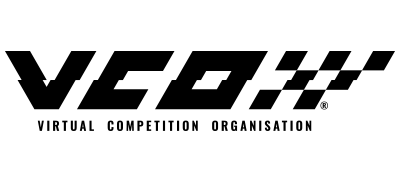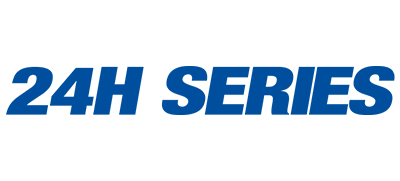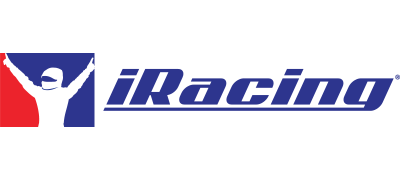NEO’s web correspondent Corey Davis continues to share his driving experiences in this In-Race Reporter series, cross-posted on neo-endurance.com and his personal blog, The Driver Diary.
September was one of my best sim racing months ever.
Admittedly, it was with a small sample size, but good results in my two events still made it a month to remember.
It began with pre-qualifying for the new NEO-sanctioned 24H SERIES ESPORTS season. I was back behind the wheel for the first time in months, but using a dedicated practice regiment with my teammate Karl and in the comfortable confines of the Porsche 911 GT3 Cup car, I was up to speed and performing under pressure once again.
We finished tenth, solidly within the top thirteen that would advance out of pre-qualifying in the 991 class. With our spot on the grid secured, our NEO preparations paused as Karl and I turned our attention to a completely different sort of challenge.
Instead of 10 hotlaps around Donington, we would try to tame the famous Mount Panorama circuit over 1000 kilometers.
Mountain Men
In our previous endurance races at Bathurst, we had a checkered past that often ended well before the checkered flag. In the Masters of Endurance series, Karl hit the wall while in top-ten contention just after the halfway point of a six-hour race in 2015. And this February, I crashed our car on the first lap of the 12-hour race — one of my most embarrassing sim racing moments ever.
But Bathurst is my favorite track, and I wasn’t about to let a bad race or two scare me away from trying again. Furthermore, competing in the Bathurst 1000 has been on my sim racing bucket list for years, but it always seemed to conflict with the start of the winter endurance racing season.
This year, that date was open on Karl’s and my calendars, so we set out to right our past wrongs at Mount Panorama. But we knew from the outset that it would be an uphill battle — literally.
In my first few test laps, I tried to drive the right-hand drive V8 Supercar just like I drove the left-hand drive Mercedes AMG GT3 car earlier this year, and it ended with similar results: Clipping the walls in the tightest parts of the track coming over the mountain.
Even after adjusting to the car and its down-under cockpit orientation, it was a struggle to complete a full 23-lap fuel run in practice without brushing a wall or spinning the notorious bucking bronco of a car.
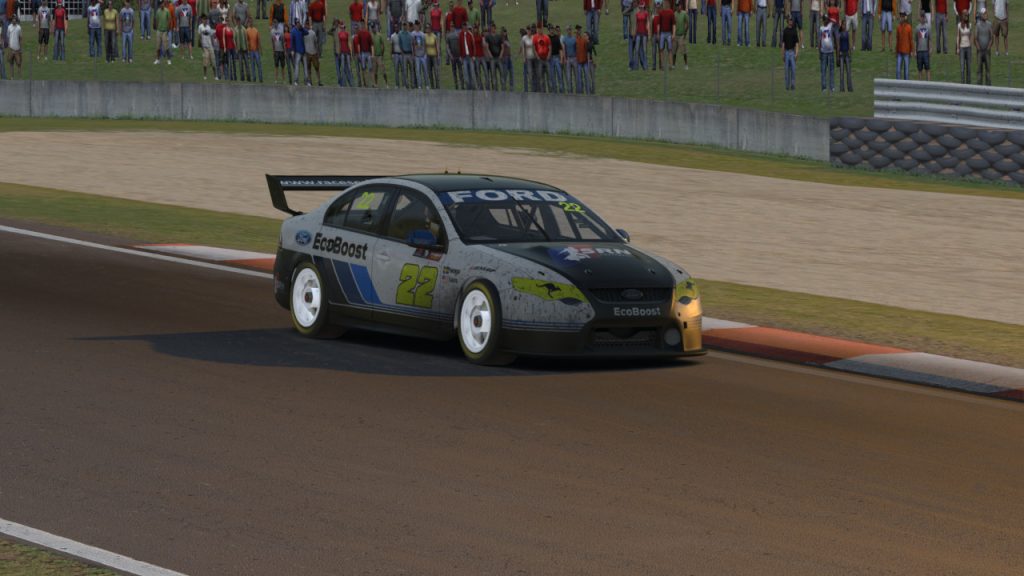
I confessed to Karl that I wasn’t feeling too confident entering the race, and we agreed that we’d almost certainly have to make damage repairs at some point. After all, negotiating a torque-happy torpedo up and down a mountain for 161 laps seemed destined to cross the margin of error at some point.
My only defense was an extra-cautious strategy of leaving an extra foot of space to all of the walls coming up the mountain, and even if I inevitably cut it a little too close, maybe I would avoid hitting anything.
Race day began with a promising start in qualifying. I had put some work into making a setup the night before, so we opted to have me set our time. My first lap was a decent banker — I overdrove turn 1 and played it safe coming over the mountain, but my time would have still landed us around twelfth or thirteenth.
Hoping to get out of the midfield, I made another run and hit turn one correctly while cutting it closer in the fast, wall-surrounded sections of the mountaintop.
Those improvements were worth four tenths in laptime, and I jumped up to eighth on the starting grid.
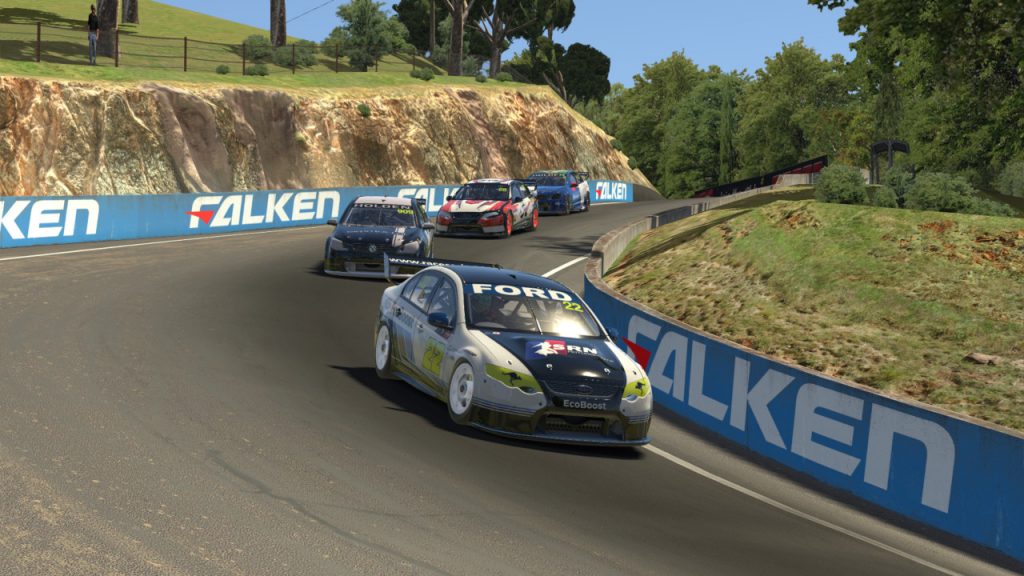
Not willing to risk another first-lap crash, we put Karl in for the start. He avoided the wall at Forrest’s Elbow on lap one — and I sheepishly reminded him that he had made it farther than I had — and he put in a clean and smart stint, distancing us from the midfield where we might have otherwise ended up if not for the late improvement in qualifying.
We were managing our tires better than our closest opponents, and by the end of the first stint, Karl had moved us up to sixth with the next few positions well within reach.
After exiting the pits, I quickly gained one of those spots to a team who had put in their slower second driver. A few laps later, I picked up another when the car ahead ran wide at turn 1. Before the end of the stint, they had crashed out while we were still motoring along in fourth.
Attrition had started to take a toll, but not as much as expected. The opening laps saw the likes of Nicki Thiim drop out, but crashes weren’t very common after that. Everyone seemed to respect the difficulty of the car and the circuit, and in the hot afternoon conditions that saw track temperatures peak at 53°C, or 127°F, no one wanted to push too hard and risk an almost certain DNF.
Through the middle of the race, Karl and I continued our strategy of changing drivers at every pit stop, and we began running faster as the track cooled off and we each found a safe but consistent pace.
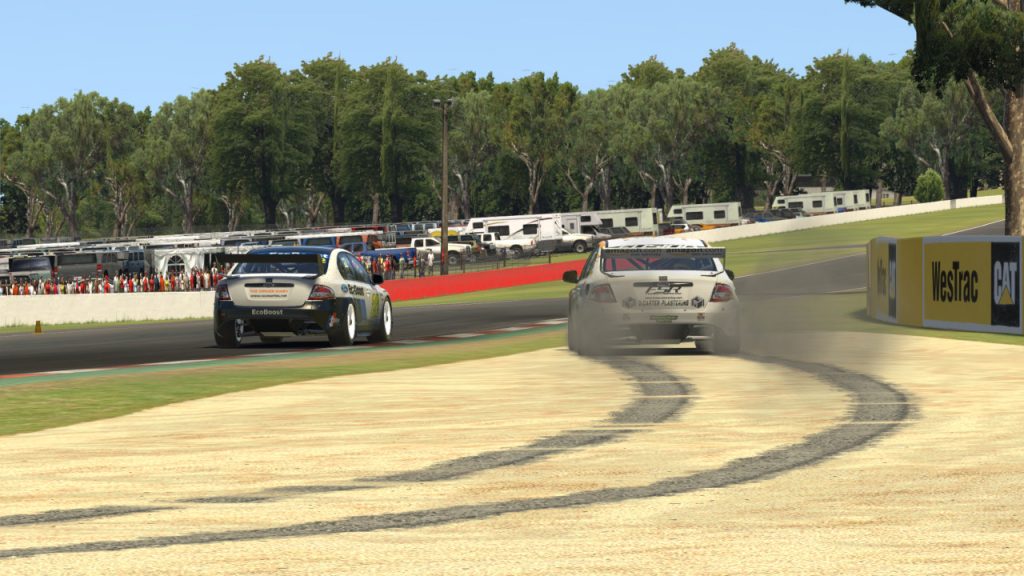
At the start of my second stint, we gained another spot and were in line for a podium. But the team behind us was effectively mirroring our lap times, so we knew it wouldn’t be easy to stay there with more than half of the race remaining.
Our better tire wear was our main advantage, and we slowly extended our advantage to around 30 seconds in the final hour. At that point, I was in the car for a double stint to the finish, and I was running quick laps at a very manageable pace.
There was one car getting closer on my relative screen, though. The race leader was catching me, and in a hurry, which made me realize my own quick laps were nothing compared to what experienced pros in the V8s are capable of.
After a lap of beating down my bumper over the mountain, they passed me on the Conrod straight, but I probably gave them a scare two turns later when I nearly rear-ended them in the final corner and had to lock the brakes and drift behind them to avoid a collision.
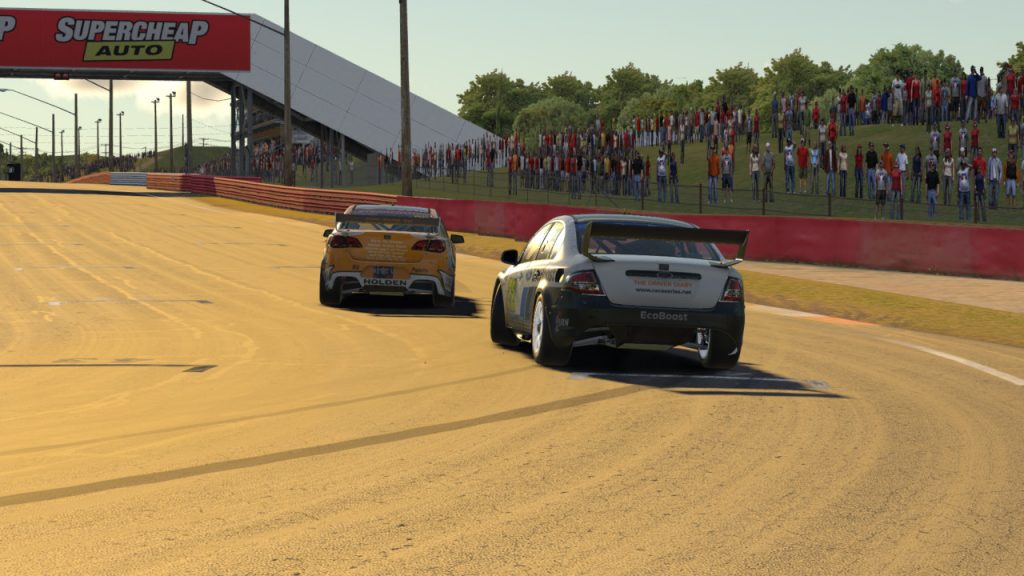
It was my closest call of the race, and neither Karl or me hit anything all day. While we weren’t in the same league as the leader, finishing in third place, only one lap down with no damage, was the sort of result we could have never dreamed of.
We ended up as the highest-placed non-Australian team in Saturday’s top split, which felt like a win given our history at the Mount Panorama Circuit and my own mixed results in the V8 Supercar.
Even if we were only the best of the rest, redemption tasted sweet after years of what-ifs at Bathurst.
Sniped at Spa
As the calendar turned to October, we didn’t expect to match our performance from the previous month — after all, our main event would be the much-more-competitive NEO season opener at Spa — but compared to previous seasons, I had more confidence in my own driving.
Whether it was a matter of overconfidence, underpreparation, or underestimating our competition, Spa was mostly a struggle.
It began in qualifying. In my practice runs, I had found that even with higher starting tire pressures, my fastest times always seemed to come on the third lap, and in a 15-minute session, I’d probably only have time for one three-lap attempt.
In my first try, I exited the pits with the Porsche pack and found a gap starting my first lap, which I knew would largely be a throwaway while the tires came up to temperature. Sure enough, it was a clean but slow lap: a 2:23.180.

My second lap was going well but was invalidated by an off-track. And on my third, I pushed too hard into Stavelot and spun into the gravel, costing me my only chance at a three-lap run.
I had enough time to get back on track and run two more laps, and the second of those was on a decent pace, but at the end of the lap, the desire to extract every ounce of performance from the car caused me to overdrive the bus stop and lose several tenths.
The result was a small improvement to a 2:22.939, but we were only thirteenth on the grid.
Expecting we’d have better pace in the race, a top-ten seemed like a reasonable goal, and with Karl again driving the start, it didn’t seem unreasonable that he might get there within his early double stint.
But our best-laid plans were doomed almost from the beginning. On lap two, the driver behind us took a defensive line into La Source but missed his braking point. Unable to slow down, he speared the car ahead of us and Karl had nowhere to go but through the wreck.

While it initially appeared that we avoided major damage, one lap later in the same corner, the engine suddenly exploded, apparently from a radiator punctured in the collision.
Karl coasted back to the pits, and together with our third teammate Ryan Huff, we assessed the damage while our virtual crew went about fixing it over the next 40 minutes.
In my previous NEO races, most of my team’s early crashes have mercifully been race-enders, keeping us from having to limp around for hours with nothing much to gain.
But in this case, the car was completely fine after the repairs, so we decided to keep going and hope to scrounge up a position — and a point — or two if other teams fell out.
While Karl started our comeback effort, I fulfilled part of my in-race reporter duties by talking with the RaceSpot commentators. We discussed the response to the new NEO season — mostly good — my team’s race — mostly bad — and the GT3 crash-marred start at Spa — a bit ugly.
They also invited an opportunity for reflection about how far NEO has come in just six years, from fledgling endurance championship to the official esports partner of the 24H SERIES.
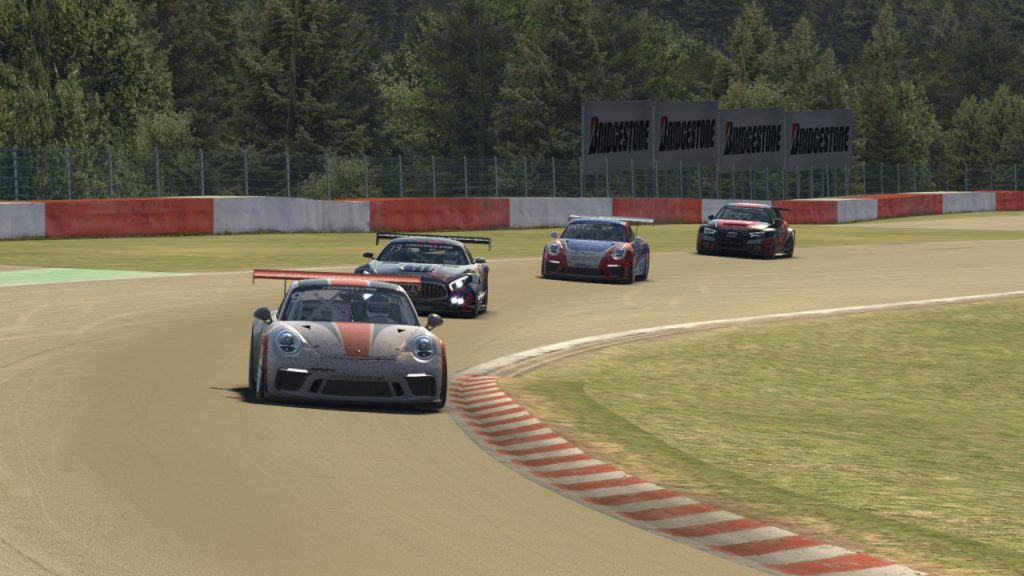
“That speaks to the level of simulator that iRacing has become. Whenever that team endurance racing feature came online, everyone was eager to be a part of that, and I think NEO had already established at that point it was doing a great job with sanctioning events and managing race control. So I think all those things combined to make that interest level so high,” I said, thinking back to the beginnings of the NEO Endurance Series.
“Even then, when registrations for the first season filled up in 15 minutes, I don’t think anyone expected that would lead to a partnership like this a few years down the line.”
From thinking about the past to preparing for the present, it was soon time for me to get in the car. While I had been scheduled for a double stint, but the damage repair time had effectively cut our race short, so I would have just one stint behind the wheel. Before that, I laid out my vision to Karl and Ryan.
“My goal is to be nice to everyone, to not make anyone mad at me, and to not ruin anyone’s race.”
It was tougher than it sounded, not because I’m a particularly aggressive driver in traffic, but because it’s almost impossible to stay out of the way while being in the middle of three classes.
I just tried to let faster GT3 and 991 cars past on straightaways to avoid any tight situations in corners, and stuck to passing TCRs on the straights instead of out-braking them or going side-by-side into any corners.
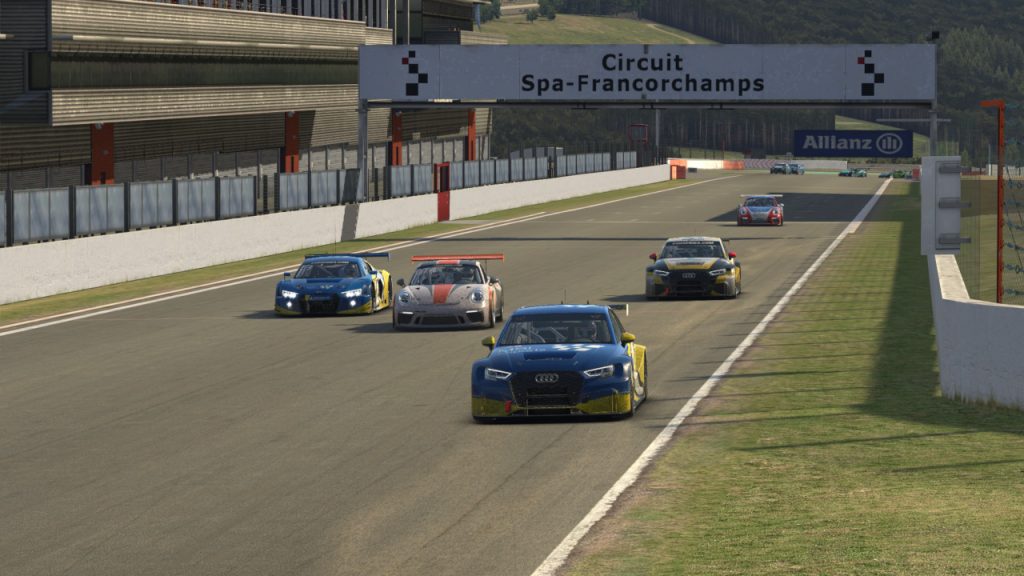
My lap times suffered as a result, which the statistics assembled by David Barraclough and Sascha Lamp reveal. I was the seventh-slowest Porsche driver based on my median lap time, and the fourth slowest based on the average of my fastest 20 laps.
When I wasn’t laying over for traffic, though, I was generally able to keep pace with a number of the midfield runners, which made me think that we could have been in that fight if not for the early crash. It was both inspiring and frustrating to keep pace with my opponents despite being 20 laps behind them.
Our five hours of cruising around did at least gain us one position when the third-place team had a steering failure at one of the fastest parts of the track.
Finishing in fifteenth, we earned a single point. It was better than nothing, but still a difficult way to start a new season, especially after our September success.
From our performance peak at Mount Panorama to the depths of frustration at Spa, maybe it just goes to show that even sim racing obeys the laws of physics.
What goes up must come down.
Related posts
Latest news
Race Replay: 6H SPA
BMW Team BS+TURNER win 12H BARCELONA
Race Replay: 12H Barcelona
- iRacing Staff Member Profile: Senior Creative and Graphics Manager Larry Fulcher
- FIA SIMAGIC F4 eSports Regional Tour Week 6 report: Rubilar extends lead, Ladic and Dunne take over in respective regions
- THIS WEEK: Skip Barber Formula iRacing Series Hot Lap Qualifier at VIR Grand
- This Week in iRacing: July 23-29, 2024
- ExoCross Storms Onto PC and Console Platforms



